Choosing the Best Flooring for Your Bedroom Space
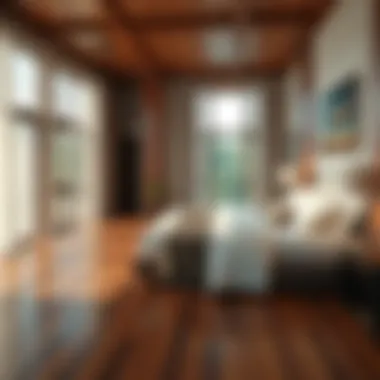
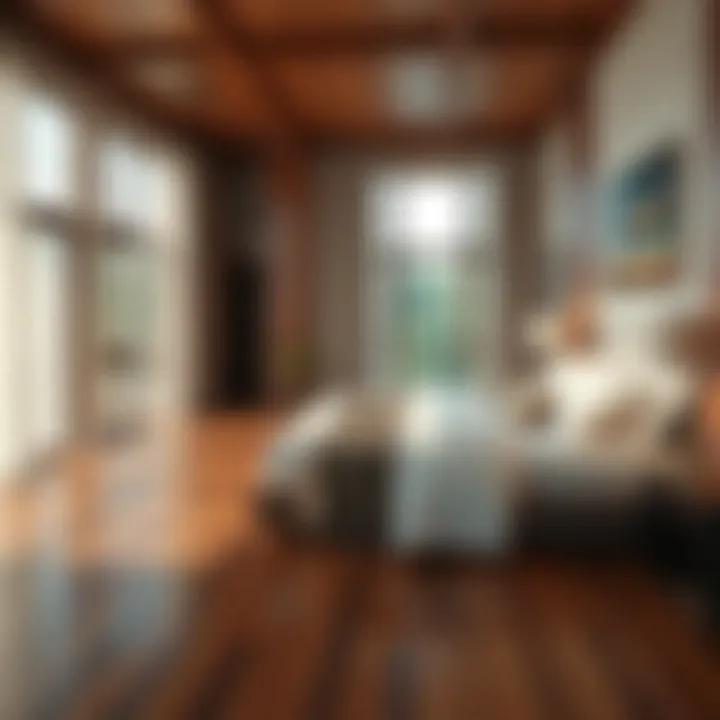
Intro
Choosing the right flooring for your bedroom is a task that one can hardly overlook when it comes to designing a comfortable living space. It sets the foundation for your entire room's atmosphere, influencing both its aesthetic appeal and functionality. The cacophony of options available today might leave one feeling overwhelmed; however, this guide will help you sift through the clutter.
The world of flooring offers a variety of materials and styles tailored to different preferences and lifestyles. From the warm embrace of carpet underfoot to the sleek elegance of hardwood, each choice brings its own unique charm and challenges. This discussion will illuminate key characteristics of various flooring options—like hardwood, carpet, laminate, and tile—while highlighting their benefits and drawbacks relevant to common bedroom use.
In exploring flooring options, we will also delve into current trends, enabling you to stay abreast of what is fresh and fashionable. Furthermore, some visual ideas shall assist in crafting your ideal sanctuary, bridging the gap between inspiration and reality. This exploration aims not only to inform but to equip you with knowledge to make thoughtful decisions reflective of your personal taste.
Whether you are sprucing up an existing room or starting from scratch, understand that the flooring you choose serves as both a functional aspect and a significant part of your bedroom's overall décor. Let's step into the heart of the matter and unpack the trends shaping modern bedroom flooring options.
Importance of Selecting the Right Flooring
Selecting the right flooring for your bedroom is not just about aesthetics. It involves a careful consideration of comfort, functionality, and long-term value. After all, your bedroom is more than just a sleeping space; it’s your personal sanctuary. The right flooring can transform this area into a haven where you can unwind and rejuvenate.
Impact on Comfort and Style
When it comes to comfort, the type of flooring you choose has a significant impact on how you feel in your space. Soft carpets, for example, provide a cozy feel underfoot—ideal for those chilly mornings when getting out of bed is the last thing on your mind. On the other hand, hardwood floors exude elegance but can be harsh when you step onto them barefoot. Finding a balance that aligns with your lifestyle is key.
Style also plays a vital role. Flooring can either complement or clash with your bedroom decor. A rustic farmhouse theme benefits from wide-plank hardwood, while a minimalist aesthetic may flourish with sleek, polished concrete. Coordinating your flooring with other elements like wall color and furniture adds cohesiveness to the overall design.
Flooring's Role in Bedroom Functionality
The functionality of your bedroom extends beyond mere sleep. It’s a space for reading, unwinding, perhaps even working from home. Considering how you use your bedroom can influence your flooring choice significantly. For instance, if you enjoy yoga or light exercises, a softer carpet can support those activities, while tile flooring might be less accommodating.
Also, think about how easy it is to maintain. Some flooring options, such as laminate, offer scratch resistance and are simple to clean, suiting busy lifestyles. Others may require more regular upkeep; for instance, hardwood can be prone to scratches and water damage without proper care.
Long-term Value Considerations
Investing in flooring isn’t just a short-term decision; it’s about long-term value too. Different flooring materials come with varied lifespans. Solid hardwood, if properly maintained, can last a lifetime and even increase the resale value of your home. Conversely, cheaper options, like low-quality laminate, may save you money upfront but could need replacement sooner, costing more in the long run.
Additionally, consider whether the flooring contributes to energy efficiency. Insulated flooring options can help maintain room temperature, potentially lowering heating and cooling bills.
Choosing the right flooring, therefore, isn't just about what you like today. It's about making a choice that enhances your comfort, fulfills your functional needs, and maintains its value over time. This multifaceted approach ensures your bedroom remains a pleasant retreat for years to come.
Hardwood Flooring Options
Opting for hardwood flooring in a bedroom setting can create a warm and inviting atmosphere that appeals to numerous homeowners. This section delves into various hardwood options, including the types that stand out and the aesthetic and practical implications that come with them. Hardwood flooring is not just about appearance; it incorporates durability, value, and comfort, making it an essential choice for a tranquil bedroom environment.
Types of Hardwood
Solid Hardwood
Solid hardwood is crafted from a single piece of timber, making it a timeless and robust selection for those looking to elevate their sleeping quarters. One of its most prominent features is its unique grain patterns, which lend a distinctive character to any room. The appeal of solid hardwood primarily lies in its ability to be refinished multiple times, which crafts longevity into its essence.
This option proves to be beneficial, particularly for those aiming for a classic look. When well cared for, solid hardwood can last several decades, enhancing both the visual appeal and value of the home. However, it comes with some downsides, such as susceptibility to moisture and fluctuations in humidity, which can lead to warping. This makes it vital to ensure proper acclimatization and maintenance.
Engineered Hardwood
Engineered hardwood, on the other hand, boasts a layered structure that combines real wood on top with plywood or high-density fiberboard underneath. This construction provides increased stability, making it a fantastic choice for homeowners residing in areas with varying humidity levels. It effectively circumvents some of the pitfalls associated with solid hardwood, thereby appealing to a broader audience.
A key characteristic of engineered hardwood is its ability to be installed above, on, or below ground level, offering endless possibilities for design and layout. The looks can be equally stunning since it can mimic the appearances of solid variants quite closely. However, one must consider that while it can withstand moisture better, it does have a finite number of times it can be refinished compared to its solid counterpart.
Aesthetic Qualities of Hardwood
In terms of beauty, hardwood flooring captivates with its organic warmth and an array of available finishes and stains, allowing it to complement diverse bedroom designs. From rustic charm to modern elegance, the flexibility in design gives homeowners the freedom to express their unique tastes. The luster and intricate grain patterns often serve to enhance natural light, creating an inviting ambiance.

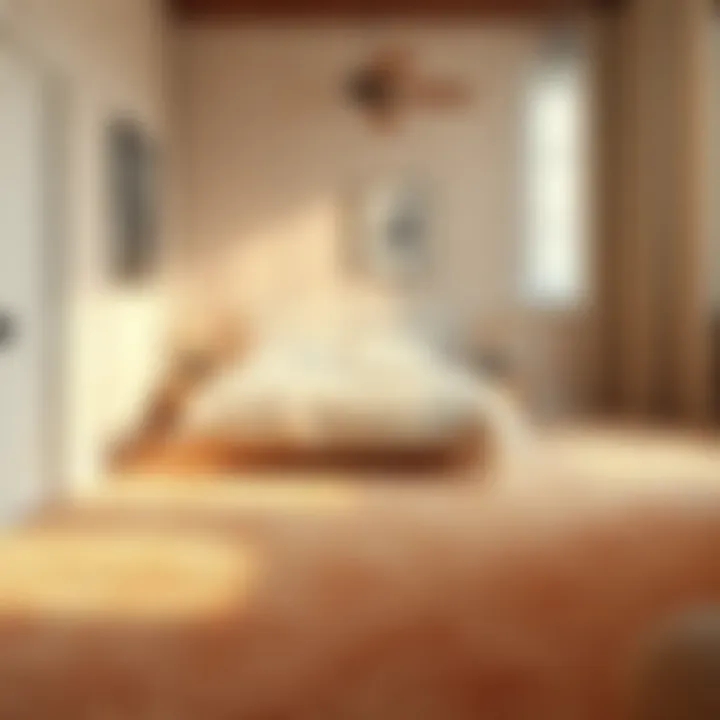
Moreover, hardwood floors can act as the backbone of your bedroom decor, harmonizing seamlessly with various styles, be it contemporary, traditional, or even industrial. *A recent study noted that homes showcasing hardwood floors had notable increases in perceived value and buyer interest, underscoring the positive aesthetic impact of hardwood flooring.*
Maintenance and Longevity
When it comes to maintenance, hardwood floors require mindful care to keep them looking their best. Regular sweeping or vacuuming to remove debris and dust is essential, along with periodic mopping using suitable cleaners. By following proper maintenance routines, homeowners can extend the lifespan of their hardwood flooring, ensuring it remains a stunning feature of the bedroom for years to come.
It's also important to consider factors such as environmental conditions; areas with high humidity may affect hardwood's performance if not managed properly. On average, solid hardwood can last up to 100 years, while engineered hardwood has a lifespan of 20-30 years depending on the quality and care. Investing in hardwood flooring not only enhances the aesthetic charm of your bedroom but also ensures a long-lasting attribute that can be enjoyed for generations.
"Hardwood flooring offers the perfect blend of beauty and durability; a choice that speaks volumes about your style and values."
Whether you opt for solid or engineered hardwood, these materials are more than just flooring; they're a significant investment in beauty, comfort, and value for your personal sanctuary.
Carpet Flooring Options
When it comes to choosing the right flooring for a bedroom, carpet flooring is often at the top of many homeowners’ lists. The warmth and comfort it provides can create a snug atmosphere that is particularly desirable in personal sanctuaries. Not only does carpet offer a variety of styles and textures, but it also enhances sound insulation and adds a layer of comfort underfoot, making it a practical choice.
Varieties of Carpet
Understanding the different varieties of carpet can help homeowners make informed decisions based on their lifestyle and aesthetic preferences.
Cut Pile
Cut pile carpets are woven with loops that are cut to create a soft and plush surface. One of the key characteristics of cut pile is its adaptability to various styles. This type of carpet can easily fit in with both contemporary and traditional decor. Its soft texture encourages a cozy feeling, suitable for bedrooms where comfort is paramount.
Despite its popularity, there are some considerations. Cut pile can show wear more quickly than some other styles, especially in high-traffic areas. On the plus side, it is generally easier to clean than loop pile. The unique feature of cut pile—its luxurious feel—is balanced by the fact that it may require occasional maintenance to keep it looking its best.
Loop Pile
Loop pile carpets, unlike cut pile, have loops that are intact and provide a denser, more durable surface. The crucial distinguishing feature of loop pile is its resistance to stains and flattening. These carpets are notably hard-wearing, making them ideal for busy households. Homeowners appreciate loop pile for its ability to withstand heavy foot traffic while still maintaining a visually appealing look.
Loop pile can also offer interesting texture options, adding an elevated element to a bedroom’s aesthetic. However, because of its dense weave, it may feel less soft than cut pile, which is something to consider depending on what a homeowner values in comfort.
Tile
Carpet tiles present another innovative flooring solution, combining the benefits of traditional carpeting with the flexibility of modern design. Each tile can be easily replaced if damaged or stained, offering a practical approach to carpet maintenance. The distinctive advantage of carpet tiles is their modularity; homeowners can create various patterns and color combinations to achieve a unique look in their bedroom.
One of the downsides is that the seams between tiles can sometimes be visible, which might not appeal to those looking for a seamless appearance. Nonetheless, their ability to adapt to various layouts and their ease of installation are compelling reasons for choosing carpet tiles.
Comfort and Insulation Benefits
Carpet flooring is often celebrated for its comfort and insulation properties. Soft and warm underfoot, carpet can help regulate the temperature of a room, making it more inviting during chilly nights. Moreover, it dampens sound—an essential feature in a bedroom where peace and quiet are valued. Less noise can lead to a more restful sleep. In addition, the cushioning effect offers support, reducing fatigue on the legs and feet when standing or walking around the bedroom.
Cleaning and Maintenance Needs
Choosing carpet also entails understanding cleaning and maintenance requirements. While certain carpets are more resistant to stains than others, all carpets will need regular vacuuming to keep them looking their best. Stains from spills should be addressed promptly to prevent deeper set-in. Depending on the type of fiber used in the carpet, certain cleaning products may work better than others.
Homeowners should consider the lifetime value of a carpet product. Some options might require professional cleaning, and understanding these needs can assist in balancing ease of maintenance with long-term investment. Choosing a carpet that suits one’s lifestyle will ultimately lead to a lasting satisfaction with the choice made.
Laminate Flooring Choices
When considering flooring options for bedrooms, one should not overlook laminate flooring. It strikes a balance between aesthetic appeal and practicality. Laminate has risen in popularity thanks to its ability to mimic the beauty of wood or stone while providing durability and affordability. With many designs available, it can suit various interior styles, making it a versatile choice for different tastes and preferences.
Characteristics of Laminate Flooring
Laminate flooring is constructed in several layers, each serving a different purpose:
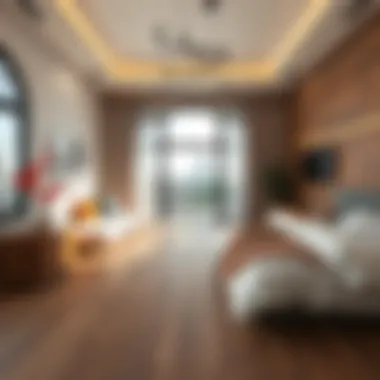

- Wear Layer: The top layer, designed to resist scratches and stains. This is crucial, especially in high-traffic areas.
- Design Layer: Beneath the wear layer, this part displays realistic patterns and textures, often mimicking natural materials like wood or stone.
- Core Layer: A dense fiberboard that provides stability and durability. It often makes laminate a good choice in homes where moisture resistance is a concern.
- Backing Layer: The bottom layer supports the entire structure and aids in moisture resistance.
These layers combine to create a flooring solution that’s not just good-looking but also functional. Laminate is relatively lightweight and can be installed over your existing floor, which can speed up the renovation process.
Cost-Effectiveness of Laminate
Considering home renovation budgets is essential. Laminate flooring is generally pocket-friendly compared to hardwood or tile. On average, laminate can cost between $1 to $5 per square foot, which translates into significant savings for homeowners looking to update their bedrooms without breaking the bank.
Moreover, the installation is often a straightforward DIY job, saving on installation costs from professionals. Many people will find laminate is easier and quicker to lay down than other flooring types, making it economical not just at the point of purchase but throughout the lifetime of the flooring.
Durability and Resistance
Durability is a primary concern when selecting flooring. Laminate excels in this area—it's designed to withstand the rigors of day-to-day life. With its robust wear layer, it can handle scratching from pets or heavy foot traffic typically associated with household activities. Additionally, laminate is resistant to fading, which means it will keep its vibrant appearance, even when exposed to sunlight for extended periods.
Perhaps one of its most attractive features is its moisture resistance. Though it shouldn’t be submerged in water, many laminate options can withstand spills if wiped up quickly. This makes it a smart choice for bedrooms, where accidental drink spills might occur.
"Choosing the right flooring reflects not just style, but also a smart investment in your home’s future."
Tile Flooring Solutions
When considering flooring options for a bedroom, tile flooring often doesn’t get the mention it deserves. It's versatile, sturdy, and comes with an array of choices. Whether you crave a chic look or just need something that can handle daily life a bit better, tile flooring presents unique solutions that can suit various tastes and requirements.
Types of Tiles
Ceramic
Ceramic tiles are a common favorite for many homeowners, and for good reason. They are practically effortless to maintain, making them a go-to option for busy lifestyles. One key characteristic of ceramic tiles is their adaptability in style; you can find them in an assortment of colors and patterns, which gives you ample space to express your personal taste.
A standout feature of ceramic is its durability. These tiles can withstand heavy foot traffic and accidental drops without a scratch. However, a downside to consider is their hardness. If you drop something fragile, it likely won’t survive the fall.
Porcelain
Porcelain tiles take the robustness of ceramic a step further. Made from a denser clay at higher temperatures, they are typically more durable than their ceramic counterparts. This attribute makes porcelain an exceptional choice for those looking for longevity in their flooring.
Moreover, porcelain tiles are often noted for their water-resistant qualities, which can be especially handy in case of unexpected spills. However, it’s worth recognizing that porcelain can be a bit pricier, so while your investment could pay off in the long run, it’s something to keep at the forefront of your mind.
Vinyl Tile
Vinyl tile has seen a resurgence in popularity due to its remarkable adaptability and budget-friendly price point. One advantage of vinyl tiles is that they can be designed to imitate natural materials, like hardwood or stone, providing an elegant appearance without the hefty price tag.
A unique feature of vinyl tiles is their softer surface, which contributes to comfort underfoot; this is particularly beneficial in a bedroom setting. However, while they are relatively easy to install and maintain, they can be somewhat susceptible to scratches and dents, especially in high-traffic areas.
Water Resistance and Longevity
A crucial factor to ponder while choosing tile flooring for a bedroom is the water resistance of specific tiles. With high water exposure in certain zones of a home, it’s essential to choose tiles that are equipped to handle moisture. This is where porcelain shines, as it tends to resist water effectively, ensuring longevity.
To enhance the lifespan of the tiles in general, proper installation and regular maintenance are key. Following basic guidelines—like sealing grout joints and cleaning spills right away—can ensure your tiles endure the test of time.
Design Flexibility with Tiles
Tile flooring boasts an impressive degree of design flexibility, which plays beautifully into personal aesthetics. With countless colors, shapes, and sizes, tiles allow homeowners to design their room according to their exact vision. You can lay them in various patterns, mix and match different styles, or create striking borders and mosaics—a creative playground for your bedroom!
"Choosing tile means you're not just selecting a floor, but also a style statement. It sets the tone for the entire room!"
Bamboo and Cork Flooring
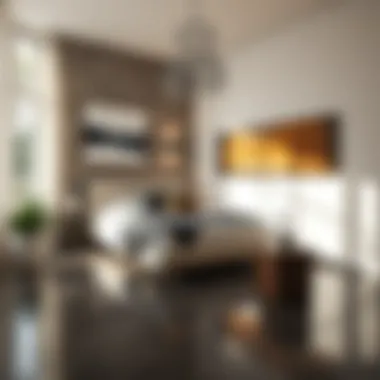
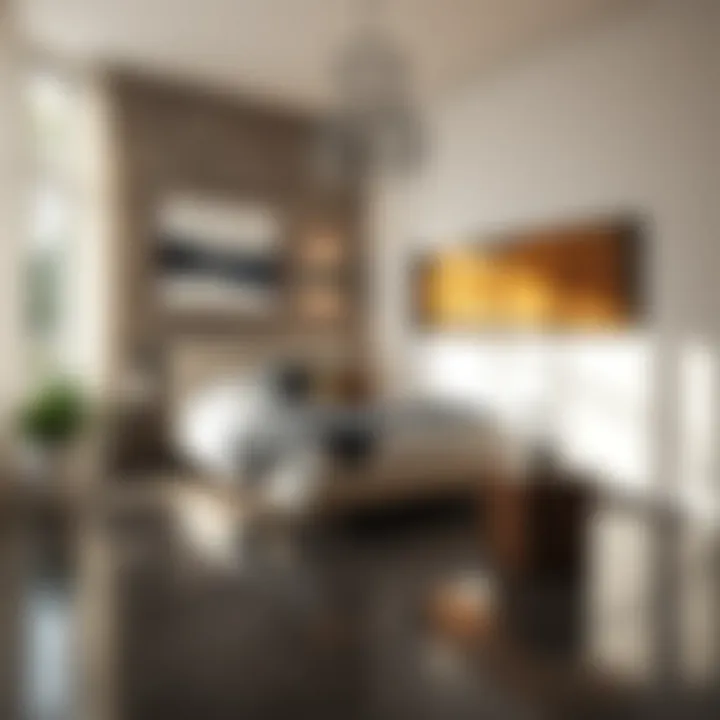
Bamboo and cork flooring are increasingly gaining traction in the world of interior design for bedrooms. As home improvement enthusiasts consider sustainability and style, these two materials rise to the occasion, striking a balance between environmental responsibility and aesthetic charm. Not only do they serve as a practical choice for flooring, but they also carry distinct benefits that might just tip the scales in their favor over traditional options.
Environmental Considerations
Bamboo and cork are generally considered eco-friendly materials. Bamboo is a grass that grows incredibly fast, often reaching maturity in about three to five years, compared to traditional hardwood trees that can take decades. This rapid growth makes bamboo a sustainable choice. Moreover, when properly harvested, bamboo can be collected without harming the plant, allowing it to regenerate without issue.
Cork, on the other hand, comes from the bark of cork oak trees, which don't need to be cut down to produce cork. Harvesting the bark occurs every nine years or so, which means the trees can continue to grow, contributing to the forest ecosystem. This extraction process contributes to carbon dioxide absorption, making cork a genuinely green option for conscientious homeowners.
Bamboo and cork flooring isn’t just about aesthetics; it’s a decision that reflects care for the planet.
Natural Aesthetic Appeal
The aesthetic allure of bamboo and cork flooring cannot be overstated. Bamboo offers a unique, sleek look that can elevate the overall design of a bedroom. The natural grains and tones of bamboo can, depending on the variety, range from warm honey hues to cooler gray undertones. This flexibility allows homeowners to find a style that fits seamlessly into their existing decor.
Cork also presents a warm and inviting ambience. With its naturally textured surface, it delivers a cozy feel that many opt for in their bedrooms. The subtle yet distinct patterns in cork can complement a wide variety of design themes, from modern minimalism to rustic charm. Not to mention, cork is available in a variety of colors, making it simple to coordinate with other elements in the room.
Sustainability and Health Benefits
When it comes to the health benefits of bamboo and cork, these materials shine brightly. For one, they are both naturally resistant to mold, mildew, and pests. This helps maintain a healthy living environment, particularly in areas where humidity can be an issue. Furthermore, cork contains a natural substance called suberin, which gives it antimicrobial properties, making it a breath of fresh air for allergy sufferers.
Moreover, both bamboo and cork provide excellent insulation, contributing to a more energy-efficient space. They help maintain comfortable temperatures, keeping the room cooler in summer and warmer in winter. This not only adds comfort but can also lead to reduced utility bills over time.
Choosing the Best Flooring for Your Bedroom
Selecting the ideal flooring isn’t just a matter of aesthetics; it affects how you experience your bedroom space. Comfort, style, and functionality all tie into this choice, making it crucial to take a comprehensive approach. Many factors come into play when honing in on the best flooring options for your particular needs, whether it's a plush carpet for those cozy mornings or a sleek hardwood design suited for modern decor. Your bedroom should be a personal retreat, and the right flooring lays the foundation for that.
Assessing Personal Preferences
First things first, let’s chat about personal preferences. Each individual has a unique taste that resonates with their style and comfort needs. Some may lean towards the warmth of carpet, appreciating how it soaks up sound and gives a soft touch to the toes. On the other hand, others might find joy in the sophistication of hardwood or laminate, drawn to their clean lines and reflective surfaces.
When assessing personal preferences, consider the overall vibe you want to create in your bedroom. What colors make your heart sing? Are you balancing a traditional aesthetic with modern accents? Maybe you adore the rustic charm of reclaimed wood or prefer the vibrant hues of patterned carpet. It’s important to not only think about what looks good but also what feels good.
Evaluating Your Bedroom's Environment
Next on the list is evaluating your bedroom's environment. Take a moment to think about the factors that impact daily life within that space. For instance, climate plays a crucial role; if you live in a cooler region, opting for a flooring type with good insulation, such as carpet, will be beneficial. Conversely, on the flip side, if humidity is a regular visitor to your area, materials like tile or vinyl could be more suitable due to their water resistance.
You’d also want to consider the level of foot traffic within your bedroom. Do you frequently have company, or is it mostly a personal haven? High-traffic settings may benefit from durable options like laminate or engineered hardwood, which can withstand wear while still looking sharp.
Balancing Budget with Quality
Finally, let’s address the elephant in the room—budget. Balancing your budget with the quality you desire is essential to making a successful flooring choice. While it’s tempting to go for the cheapest option, remember that flooring is an investment that should stand the test of time. For example, you might think laminate is a wallet-friendly choice at first glance, but if it requires replacement sooner than you hoped, it could end up costing you in the long run.
Identify your budget clearly, and then start comparing flooring options within that range. Don’t shy away from seeking out sales or discount offers; high-quality materials sometimes come with lower price tags during specific seasons.
"The best flooring isn’t always the most expensive one; it’s the one that fits your lifestyle and budget while looking graceful doing it."
Furniture and Flooring Compatibility
Choosing the right flooring goes hand in hand with selecting furniture. It's not just about what's underfoot; it's also about how everything works together in a room. When you think about furniture and flooring compatibility, you need to consider a few essential elements that can make or break the whole aesthetic.
To start with, Color Coordination plays a pivotal role in creating harmony within the space. The hues of your flooring can either complement or clash with the shades of your furniture. For instance, dark mahogany hardwood pairs beautifully with lighter-colored upholstery. This contrast creates visual interest without overwhelming the senses. Similarly, if you're opting for a plush beige carpet, you might want to choose furniture in earth tones to keep the atmosphere inviting and cozy.
"Color is a power which directly influences the soul." - Wassily Kandinsky
When you're piecing together these elements, always well to keep in mind the Mood you want to cultivate in the bedroom. Are you looking for something warm and inviting or perhaps something a bit more dramatic? The combination of colors could lead you toward one atmosphere or another.
Moving on to the next key element: Texture Contrast and Harmony. The texture of your flooring creates an additional layer of depth in the overall look of the bedroom. Consider a smooth, polished wooden floor against the soft, plush feel of a velvet armchair or a chunky knit throw. This type of variation can produce a playful yet sophisticated vibe. Alternatively, if you have a textured laminate or a shaggy carpet, it might be wise to go for more streamlined and sleek furniture designs to maintain balance.
Choosing fabrics and finishes that echo the flooring can enhance the continuity between the two. Light, airy curtains can lend a touch of softness over a hard tile floor, while heavy drapes might work better with plush carpet, providing a contrasting feel.
Incorporating these aspects fosters a room that feels intentional and thoughtfully designed. By paying close attention to the interplay between your furniture and flooring, you set the stage for both beauty and functionality in your sanctuary. It ensures that every piece complements one another, nurturing a seamless flow throughout the space.



